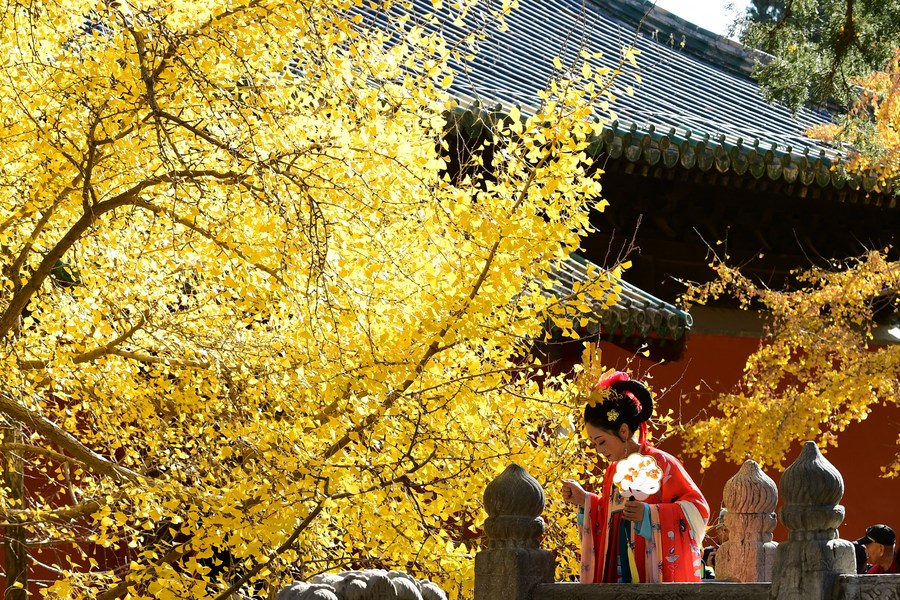
A tourist wearing Hanfu, or Han-style costumes, stands beside an ancient ginkgo tree at Dajue Temple in Beijing, capital of China, Nov. 11, 2019. (Xinhua/Yin Dongxun)
XI'AN, June 24 (Xinhua) -- Wearing a long gown with loose sleeves and elaborate embroidery while touring the ancient city wall of Xi'an, Wei Fangbing could easily pass for someone from the ancient times were it not for her smartphone.
Hailing from northeast China's Liaoning Province, Wei is a devotee of hanfu, a type of traditional garment of the Han ethnic group. The early 20-something bought the eye-catching outfit well before her trip to Xi'an, a historical city in northwest China best known for the Terracotta Warriors.
"On social media, I saw many people visited Xi'an wearing hanfu. They look very gorgeous," she said. "The outfit's retro style goes particularly well with Xi'an."
Wei is among a growing number of young hanfu fans in China who have been charmed by the traditional attire's unique design and the rich culture behind it.
According to a report by Chinese consulting agency iiMedia Research, the number of hanfu enthusiasts in the country will have surged from 2.04 million in 2018 to 6.89 million by the end of this year, with over 70 percent of the fans being Generation Z-ers aged between 16 and 24.
The ongoing hanfu craze is certainly palpable. If you walk into parks and tourist spots in cities like Xi'an, Hangzhou and Nanjing, chances are you will come across people dressed in hanfu taking selfies.

A woman in Hanfu, or Han-style costumes, poses for photos in snow at the West Lake scenic spot in Hangzhou, capital of east China's Zhejiang Province, Dec. 31, 2018. (Xinhua/Huang Zongzhi)
To tap into the fad, some tourist attractions have held hanfu-themed events and offered discounts and waivers for admission tickets to visitors wearing hanfu.
Last year, the ancient town of Xitang in east China's Zhejiang Province attracted some 187,000 tourists during its hanfu cultural week, including more than 86,000 visitors dressed in the traditional garment.
Zhu Keli, a researcher on new economy with the Development Research Center of the State Council, said the growing popularity of hanfu among Chinese young people arises from their increasing appreciation for traditional culture and their need to express their individuality.
The new economy and e-commerce platforms have further spurred the development of the niche market, Zhu said.
The report by iiMedia Research predicted the sales volume of China's hanfu market to exceed 10 billion yuan (about 1.5 billion U.S. dollars) this year.
The booming market has been attracting an increasing number of young, hanfu-loving entrepreneurs.
Wu Qiuqiao, 27, owns a shop on Taobao, China's major online shopping platform, which mainly sells specially-designed hanfu for pet cats. Wu opened the shop in 2019 after quitting her previous job in Beijing to pursue her real interests -- hanfu and cats.
"I was trying to do something different, and the idea of hanfu for cats is so original and combines my top two interests," she said.
The novel idea has turned out a big success. To date, Wu's shop has garnered over 16,000 followers on Taobao, with the highest monthly sales topping 70,000 yuan.
Wu said her main concerns when designing hanfu for cats are how to make the clothing more comfortable for the animals and how to retain the original flavor of hanfu.
"I'm happy that the special hanfu can win the hearts of so many cat owners," she said. ■




